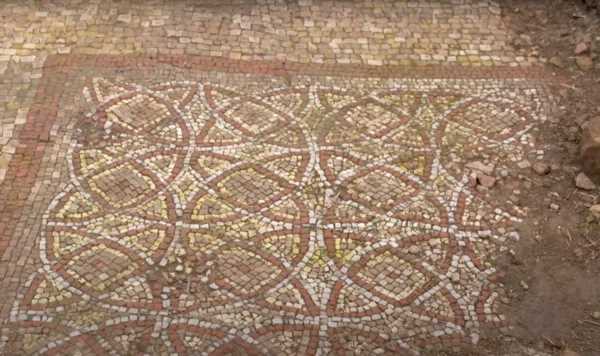
Netherlands: Roman sanctuary discovered in Gelderland
We use your sign-up to provide content in ways you’ve consented to and to improve our understanding of you. This may include adverts from us and 3rd parties based on our understanding. You can unsubscribe at any time. More info
Experts have been left “gobsmacked” after unearthing a “treasure trove” of more stunning following excavations at a Roman villa found beneath a farmer’s field in Rutland. Archaeologists returned to the location in Rutland where they found a spectacular Roman mural in 2021 to carry out further excavations, only to stumble across more fascinating finds. The experts were shocked to find another mosaic and more building remains at the site.
Among the finds was a building with a large hall around 50m (164ft) away from the villa, containing a bath suite with hot and cold rooms and extensive living spaces. It is believed that the building was occupied between the 3rd and 4th century AD during the late Roman period.
The so-called “hot room” had sophisticated underfloor heating and heating ducts built into the walls, while a tank outside the building may have been used to collect water from the roof.
Experts have speculated that the extended family of the villa owners’ inhabited the hall, which Historic England has compared to a 4th or 5th century barn conversion.
The barn was supported by big timber posts and it is thought that it could have been two storeys’ tall. It was converted to stone in the third or fourth century, according to experts, with one end being developed into a dwelling with several floors, while the other had been kept for agricultural or craft work.


The second mosaic is thought to be part of a dining or entertaining area of the villa and an intricate geometric pattern is displayed on it. According to Historic England, this adds weight to the theory that the villa belonged to a wealthy individual.
John Thomas, deputy director of the university’s archaeological services, said: “The (Lliad) mosaic is a fantastic eye-catching find, but it’s just one element of a much bigger settlement that we now know of from the geophysics. The survival is just fantastic, it’s a complete one-off really.”
Jennifer Browning, a projects officer with the University of Leicester archaeological services, said: “It’s amazing; it sort of makes up for all the muddy ditches that I’ve spent a lot of my time in. Being able to work on something like this, it brings you a lot closer to the people that were living here.”
When the site was originally discovered in 2021, Historic England hailed the find as “the most exciting Roman mosaic discovery in the UK in the last century”.

Jim Irvine, the son of a farmer, first spotted some old pottery in one of his dad’s fields during late 2020 amid the Covid pandemic. He later returned to the spot with his family and they dug up the stunning mural.
They then told the local archaeological finds officer and Historic England, which led to experts from the University of Leicester coming in to carry out more detailed excavations and surveys.
Mr Thomas added: “It’s difficult to overstate the significance of this Roman villa complex to our understanding of life in late Roman Britain. While previous excavations of individual buildings, or smaller-scale villas, have given us a snapshot, this discovery in Rutland is much more complete and provides a clearer picture of the whole complex.
“The aim of this year’s work has been to investigate other buildings within the overall villa complex to provide context to the Trojan war mosaic. While that is a wonderful, eye-catching discovery, we will be able to learn much more about why it was here, and who might have commissioned it, by learning about the villa as a whole.”
DON’T MISS
National Grid cancels energy-saving blackout prevention plan [REVEAL]
Evidence of ancient Neanderthal hunter in the English Chanel [REPORT]
Putin’s energy threat to kill 150,000 Europeans from winter bills [INSIGHT]


Historic England has contributed £193,000 to fund this excavation work this year after the first mural was found, which features a stunning artistic interpretation of the Trojan War.
Historic England’s Chief Executive, Duncan Wilson, said: “This is a fascinating site and has posed many questions about life in Roman Britain. The answers will become clearer as the evidence is examined over the next few years by a team of specialists, and their work will help us understand the story of this villa complex, and its significance for our understanding of Roman Britain.”
Experts will continue to conduct research on the artefacts recovered from the villa complex wi in the coming years, although there currently are no plans for further excavations. The complex’s exact location in Rutland is for the moment being kept secret and it has now been covered back up in order to keep it preserved.
Ian Barnes, Historic England Senior Archaeologist and Project Manager of HE excavation, said: “This year’s excavations by Historic England and ULAS have further revealed what a remarkable place this was during Roman times. A place built for comfort, and clearly to impress – but who?
“I’m looking forward to the analysis of our findings, which will tell us so much more about the people who lived here, and their connections. Just as exciting was the chance to work with over a hundred people over the summer, in partnership with ULAS, and including University of Leicester students, volunteers from the local community and Historic England staff learning new skills: hopefully the experience has not only brought them into close contact with the Romans but also taught them much about archaeology, and something about themselves.”
Source: Read Full Article